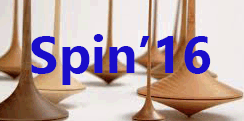Speaker
Description
Spin-orbit coupling plays an important role in nuclear structure and reactions. Scattering asymmetry in differential cross section of elastic scattering, i.e. analyzing power, is a a direct consequence of the spin-orbit coupling between the proton and the target nucleus. Extensive experimental data exist for stable nuclei on this subject, while almost no experimental attempts have been made for unstable nuclei. It is interesting to investigate how an exotic structure of the neutron-rich nucleus affects the spin-orbit coupling in proton-nucleus scattering. As unstable nuclei are short-lived and provided as a radioactive-ion (RI) beam, a spin-polarized proton target is required to probe spin-dependent interactions. Until recent, such measurements have not been possible due to the lack of target capable to work under conditions of RI beam experiments. Namely, to measure proton elastic scattering, accurate measurement of proton angle is required. Conventional polarized targets, which work under high magnetic fields of about 2.5 T severely distort protons trajectory. To overcome this a target capable to work at a low magnetic field of 0.1 T was developed by Center for Nuclear Study (CNS), University of Tokyo and RIKEN group. With this target it becomes possible to accurately measure trajectory of recoil protons.
In summer of 2016 we carried out an experiment at RIKEN, RIBF on p– 6He scattering at 200 A MeV to probe spin-orbit potential between a proton and 6He. 6He beam at intensity of 500 kpps was provided to the polarized proton target. Recoil protons were measured by Recoil Proton Spectrometers (RPS) developed in RIKEN. RPS consists of a drift chamber, plastic scintillator for energy loss measurement and NaI(Tl) calorimeters. Two spectrometers were
placed symmetrically to the left and right of the beam line at 1 m distance from the target to cover 55◦−70◦ angular region in the laboratory frame. In addition, for determination of absolute target polarization, p–4He elastic scattering was measured.
In this presentation we are going to describe our experimental setup and provide preliminary results. Brief overview of other experiments at RIBF, which were made with polarized target will be given.
